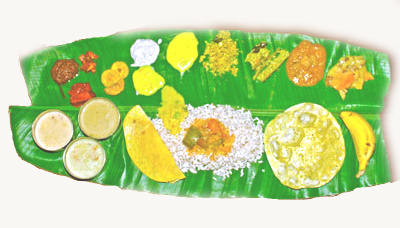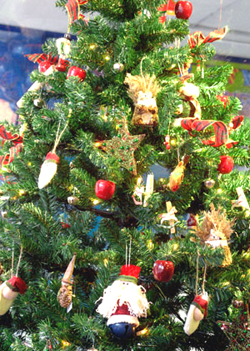Fesivals

Onam - Onam is one of the most significant harvest festivals of Kerala. It was said that the King ruled Kerala long time ago and that he was a good King who looked after his people well. The people also have the belief that during Onam, the King returns to Kerala to visit his people. Carnival of Onam lasts for ten days and brings out the best of Kerala culture and tradition. Intricately decorated Pookalam, ambrosial Onasadya, breathtaking Snake Boat Race and exotic Kaikottikali dance are some of the most remarkable features of Onam - the harvest festival in Kerala.
Onam is a festival of festive celebrations. New clothes are bought on this day and people indulge themselves in dances and sports. One of the main attractions of Onam, is the 'Vallamkali' or boat races of Karuvatta, Payippad, Aranmula and Kottayam. Hundreds of oarsmen row traditional boats to the rhythm of drums and cymbals. These long graceful Snake Boats called 'Chundans' are named after their exceedingly long hulls and high sterns that resemble the raised hood of a cobra.
Diwali (Deeapavali) - Diwali has been given the traditional name of 'festival of lights' because of the hundreds and thousands of small oil lamps or diyas lighted by many households. The burning of these diyas are considered to be the lighted pathway of a person's expression of happiness and also a manner of paying obeisance to God, the Supreme power for attainment of health, prosperity, knowledge, financial security and peace in one's life.
'The festival of lights' is celebrated with much enthusiasm and zeal in all of north India. In fact the festival of Diwali is regarded to bring the supernatural joy and brightness in a person's life with the hope of discovering light amidst darkness, achieving happiness in place of ignorance and spreading of love amidst hatred and violence. The tradition of lighting the diyas on Diwali holds much importance as in Hindu mythology the light signifies goodness and vitality. In cities candles and classy neon lights often substitute these diyas.
Ramzan-Id - Ramadan is the ninth month in the Islamic Calendar Year, a month when the "Holy Koran or Quran" was revealed up from heaven by Allah for human beings in 615 AD,as a guidance and declaration. Throughout the world, Muslims observe the Ramadan month by fasting and through increased concentration for purification of soul to increase closeness with God. It is a period of worship and contemplation.
During Ramadan, it is common for Muslims to go to the Masjid (Mosque) and spend several hours praying and studying the Quran. In addition to the five daily prayers, during Ramadan Muslims recite a special prayer called the Taraweeh prayer (Night Prayer). The length of this prayer is usually 2-3 times as long as the daily prayers. Some Muslims spend the entire night in prayer.
On the evening of the 27th day of the month, Muslims celebrate the Laylat-al-Qadr (the Night of Power). It is believed that on this night Muhammad first received the revelation of the Holy Quran. And according to the Quran, this is when God determines the course of the world for the following year.

Christmas – Christmas the birth anniversary of Jesus Christ, is celebrated in India with great fervor all over India by the Christians. People decorate their houses, erect Christmas trees, make cribs with figures of baby Jesus, Mother Mary, Joseph, the three kings who come to visit the baby and shepherd boys and their herds grazing around depicting the scenes of Jesus's Birth in the Bible. They decorate the Christmas tree, hang stars, gifts and illuminate them.
All the major Indian cities wear a festive look. Shops and bazaars are decorated for the occasion and offer attractive bargains. Carol singing, get-togethers and the exchanging of gifts enhance the Christmas spirit. This is the most important and the gayest festival of the Christians. Other communities in India also look upon it as a festival of goodwill and greetings. During the British period it was celebrated on an All-India basis and the ten days from the Christmas Eve i.e the evening of 24th December till after the New year were declared as public holidays. Children and youngsters looked forward to Christmas holidays when they enjoyed themselves to their heart's content.
Bakr-Id - Bakr-Id is celebrated from the tenth to the twelfth day in the Islamic month of Dhul Hijjah. Bakr-Id The feast of Bakr-Id is an occasion to give and to sacrifice. It is a day to thank the Almighty for one's good fortune and to share it with the less fortunate brethren. The concept of sacrifice is better understood through a legend from the Old Testament.
Legend has it that Allah commanded Hazrat Ibrahim (Abraham) to sacrifice his son Ismail on Mount Mina near Mecca. Ibrahim, unable to see himself kill his son, blindfolded himself and carried out the pronouncement of God. When he took off the blindfold, a lamb lay slaughtered on the altar and his son stood there unharmed.
Ibrahim understood then that this willingness on Ibrahim's part to give up his only son was what God sought, and not the sacrifice of human flesh and blood. The legend ascertains that all God requires of man is a surrender of his will and self. Like Ibrahim, who willingly surrenders his beloved son to God, a true follower of Islam is expected to sacrifice something that is dear to him.
The animal sacrifices made during Bakr-Id are mainly to provide food to the poor and to commemorate the noble act of Ibrahim. This spirit of sacrifice is what truly underlines the spirit of Bakr-Id. Incidentally, the day also coincides with the day when the holy Quran was declared complete.
Shivarathri - Maha Shivaratri is celebrated throughout the country; it is particularly popular in Uttar Pradesh. Maha Shivratri falls on the 14th day of the dark half of 'Margasirsa' (February-March). The name means "the night of Shiva". The ceremonies take place chiefly at night. This is a festival observed in honour of Lord Shiva and it is believed that on this day Lord Shiva was married to Parvati.
On the day of Shivaratri, a three-tiered platform is built around a fire. The topmost plank represents swargaloka (heaven), the middle one antarikshaloka (space) and the bottom one bhuloka (earth). Eleven urns or kalash, are kept on the swargaloka plank symbolising the eleven manifestations of the Rudra Shiva. These are decorated with bilva (woodapple leaves) and mango leaves atop a coconut representing the head of Shiva. The uncut shank of the coconut symbolizes his tangled hair and the three spots on the fruit Shiva's three eyes.
The day is considered to be specially auspicious for women. According to one myth, Parvati performed tapas, and prayed and meditated on this day to ward off any evil that may befall her husband on the Moonless night. Since then, Mahashivaratri is also believed to bean auspicious occasion for women to pray for the well-being of their husbands and sons. An unmarried woman prays for a husband like Shiva, who is considered to be the ideal husband.
Vasanta Panchami - This is an important bathing day. All Hindus observe it. It is also known as Magh Sukla Panchami as it falls in the month of Magh (January-February). This is the festival that marks the first day of spring. Vasanta means the spring season, which is very congenial for doing vigorous Yoga Sadhana.
Men, women and girls wear yellow cloth. The yellow colour is a sign of auspiciousness and spirituality. It represents the ripening of the spring crops. Even the food is coloured yellow by using saffron. All the folk get together and sing songs connected with spring.
All get up in the early morning, take bath and worship the sun, Mother Gang, the Deity of the sacred river Ganges, and the earth. The Bengalis call this festival Saraswathi Puja. They worship the Goddess Saraswathi on this day. The image of the Goddess is taken in procession and immersed in the holy Ganges.
|

